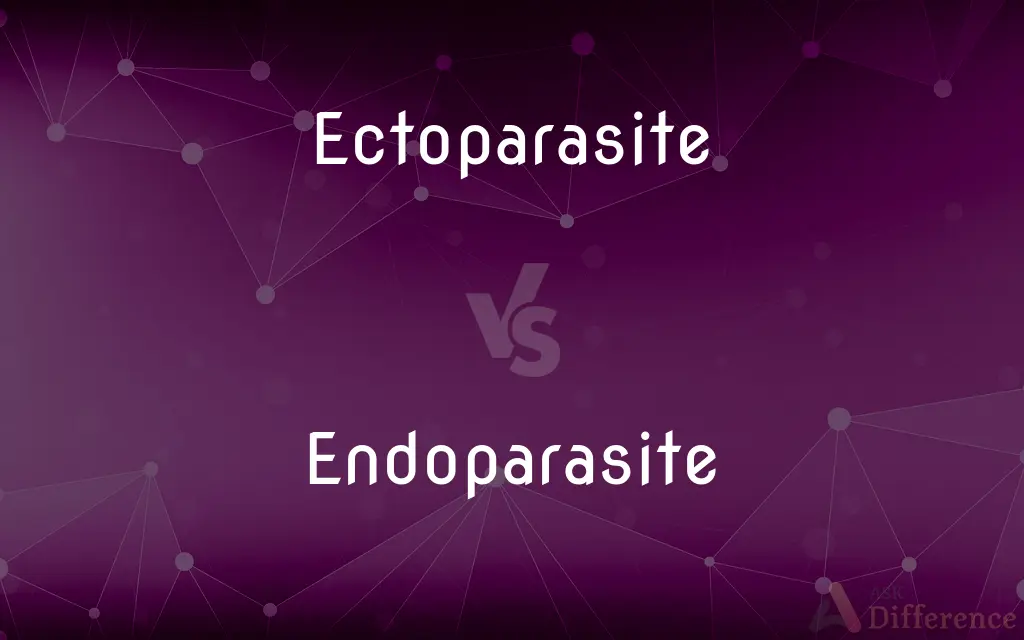Ectoparasite vs. Endoparasite — What's the Difference?
Edited by Tayyaba Rehman — By Fiza Rafique — Updated on May 8, 2024
An ectoparasite lives on the surface of its host, like fleas on mammals, while an endoparasite lives inside the host's body, such as tapeworms in the intestines.

Difference Between Ectoparasite and Endoparasite
Table of Contents
ADVERTISEMENT
Key Differences
Ectoparasites are parasites that live externally on the host's body surface, feeding on its blood or other external tissues. Examples include fleas, ticks, and lice, which typically cause irritation and skin conditions. Endoparasites, on the other hand, live inside the host's body, often residing in organs or tissues. They can cause various internal health issues, such as tapeworms in the intestines or liver flukes.
Ectoparasites are often mobile and may jump or crawl from host to host, whereas endoparasites tend to rely on more complex life cycles that involve one or more hosts for transmission.
Ectoparasites are easier to detect since they are visible on the body, while endoparasites are often diagnosed through symptoms or medical tests due to their internal location.
Ectoparasites can also act as vectors, transmitting pathogens to the host, while endoparasites primarily cause damage through direct parasitic action.
Comparison Chart
Location
Surface of host
Inside host's body
ADVERTISEMENT
Examples
Fleas, ticks, lice
Tapeworms, roundworms
Mobility
Often mobile
Dependent on life cycle
Detection
Visible on host
Symptoms/medical tests
Vector Role
Can transmit diseases
Usually not a vector
Compare with Definitions
Ectoparasite
A parasite that lives on the host's external surface.
Fleas are ectoparasites that live on cats and dogs.
Endoparasite
A parasite that lives inside the host.
Tapeworms are endoparasites that inhabit intestines.
Ectoparasite
A parasitic organism found on the body surface.
Lice are ectoparasites that thrive on human scalps.
Endoparasite
An organism that feeds internally in the host.
Roundworms are endoparasites found in the gut.
Ectoparasite
A parasite that does not enter the host's body.
Mites are ectoparasites that attach to the skin.
Endoparasite
A parasite that enters and multiplies inside the body.
Hookworms are dangerous endoparasites in humans.
Ectoparasite
A parasite living outside the host.
Bedbugs are annoying ectoparasites that infest bedding.
Endoparasite
A parasite that completes part of its lifecycle within a host.
Malaria-causing protozoa are endoparasites found in blood.
Ectoparasite
An organism that feeds on skin or blood from outside.
Ticks are common ectoparasites affecting livestock.
Endoparasite
A parasitic organism residing within host tissues.
Liver flukes are endoparasites living in bile ducts.
Ectoparasite
A parasite, such as a flea, that lives on the exterior of another organism.
Endoparasite
A parasite, such as a tapeworm, that lives within another organism.
Ectoparasite
A parasite that lives on the surface of a host organism; such as the Demodex mite, which lives in human hair and eyelashes.
Endoparasite
A parasite that lives inside the body of an organism, such as a tapeworm.
Ectoparasite
Any parasite which lives on the exterior of animals; - opposed to endoparasite.
Endoparasite
Any parasite which lives in the internal organs of an animal, as the tapeworms, Trichina, etc.; - opposed to ectoparasite. See Entozoön.
Ectoparasite
Any external parasitic organism (as fleas)
Endoparasite
Any of various parasites that live in the internal organs of animals (especially intestinal worms)
Common Curiosities
Can ectoparasites and endoparasites infect the same host?
Yes, a single host can harbor both types, such as a dog infested with fleas (ectoparasites) and roundworms (endoparasites).
What is the primary difference between ectoparasites and endoparasites?
Ectoparasites live externally on a host's surface, whereas endoparasites live internally within a host's body.
Are ectoparasites easier to treat than endoparasites?
Treatment of ectoparasites can be simpler due to their external location, unlike endoparasites which require systemic medications.
Do ectoparasites or endoparasites spread diseases more easily?
Ectoparasites often transmit diseases due to their mobility and surface feeding, while endoparasites usually cause direct damage.
Which type of parasite is more mobile, ectoparasites or endoparasites?
Ectoparasites tend to be more mobile, moving across surfaces or between hosts, while endoparasites often have more complex, internal life cycles.
Can ectoparasites cause secondary infections?
Yes, the bites or wounds caused by ectoparasites can become infected or lead to transmission of pathogens.
Can ectoparasites infest indoor environments?
Yes, ectoparasites like bedbugs can thrive indoors, often requiring pest control measures.
Are there effective preventive measures against endoparasites?
Proper hygiene, food safety, and veterinary care can prevent many endoparasitic infections.
Are endoparasites visible without medical testing?
Generally, no. Endoparasites are internal and often require medical testing to diagnose.
Do ectoparasites affect humans directly?
Yes, ectoparasites like lice and bedbugs can infest humans, causing skin irritation and discomfort.
Do endoparasites always require a secondary host?
Not always; some endoparasites can complete their lifecycle in one host, while others require intermediate hosts.
What animals are commonly affected by ectoparasites?
Domestic pets like dogs and cats, as well as livestock, are frequently affected by ectoparasites.
What is an example of an endoparasite infection?
Tapeworm infection, where the parasite resides in the intestines, is a common example of endoparasitism.
Which type of parasite has a higher reproductive rate, ectoparasites or endoparasites?
Reproductive rates vary, but endoparasites often produce a large number of eggs or offspring due to complex life cycles.
Are endoparasites exclusive to certain animals?
Endoparasites can infect a range of animals, including humans, each with specific parasites adapted to their biology.
Share Your Discovery

Previous Comparison
Kasha vs. Barley
Next Comparison
Weed vs. MarijuanaAuthor Spotlight
Written by
Fiza RafiqueFiza Rafique is a skilled content writer at AskDifference.com, where she meticulously refines and enhances written pieces. Drawing from her vast editorial expertise, Fiza ensures clarity, accuracy, and precision in every article. Passionate about language, she continually seeks to elevate the quality of content for readers worldwide.
Edited by
Tayyaba RehmanTayyaba Rehman is a distinguished writer, currently serving as a primary contributor to askdifference.com. As a researcher in semantics and etymology, Tayyaba's passion for the complexity of languages and their distinctions has found a perfect home on the platform. Tayyaba delves into the intricacies of language, distinguishing between commonly confused words and phrases, thereby providing clarity for readers worldwide.
















































